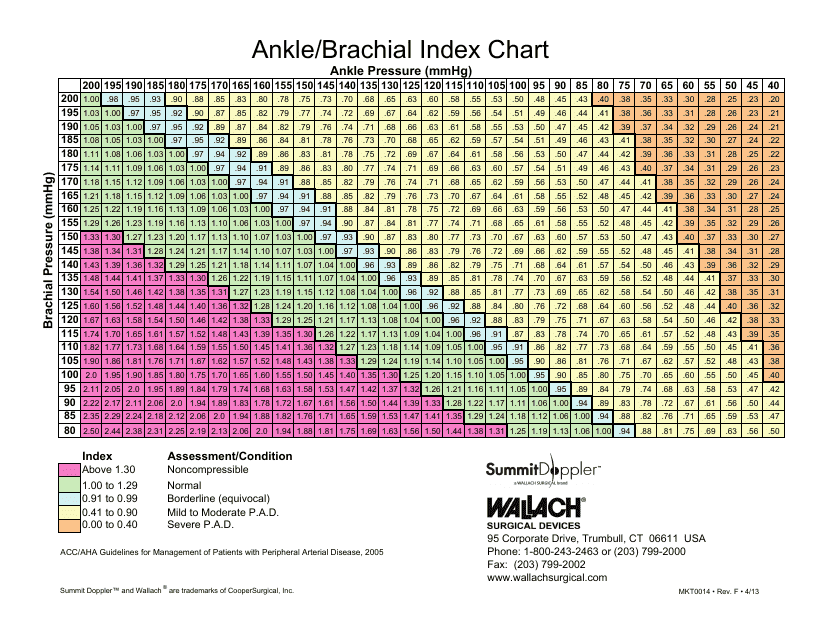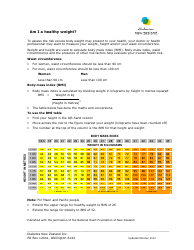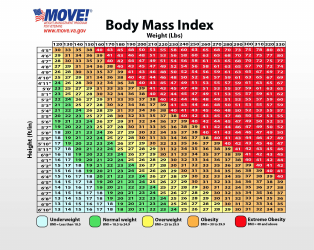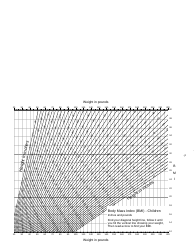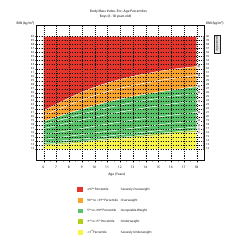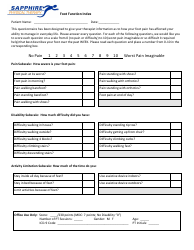Ankle / Brachial Index Chart
The Ankle/Brachial Index (ABI) Chart is a simple, non-invasive diagnostic tool used in medicine to check for peripheral artery disease (PAD). It compares the blood pressure in the patient's ankle with the blood pressure in the arm. The ratio derived from this comparison helps healthcare professionals to identify potential circulatory problems that may lead to blocked arteries in the arms or legs, stroke, or heart disease. Lower values of the ABI (less than 1.0) usually indicate the presence of PAD. This test is valuable in early detection and treatment planning for patients at risk for cardiovascular diseases.
The Ankle/Brachial Index (ABI) chart is typically filed by healthcare professionals such as doctors, nurses, or medical technicians. This document is used widely within the medical community to assess the severity of peripheral arterial disease, a condition which can limit blood flow to the legs and feet. Medical facilities handling these tests are responsible for filing and maintaining these records.
FAQ
Q: What is an Ankle/Brachial Index Chart?
A: An Ankle/Brachial Index (ABI) Chart is a simple, non-invasive tool used in diagnosing Peripheral Arterial Disease (PAD). It compares the blood pressure in the patient's ankle with the blood pressure in their arm.
Q: How is Ankle/Brachial Index Chart used?
A: It is used by doctors to determine how well blood is flowing in the limbs. A lower index (generally less than 1.0) signifies that there may be a blocked artery or other problem.
Q: What does the result of Ankle/Brachial Index Chart mean?
A: The ABI result can determine the severity of PAD. For example, an ABI of 1.0-1.4 is considered normal, 0.8-0.99 suggests mild PAD, 0.4-0.79 indicates moderate PAD, and below 0.4 signifies severe PAD.
Q: What is Peripheral Arterial Disease?
A: Peripheral Arterial Disease is a common circulatory problem in which narrowed arteries reduce the blood flow to your limbs. This condition often causes pain and numbness, especially in the legs.
Q: Who needs an Ankle/Brachial Index Check?
A: Those who are at risk of PAD, like those who smoke, have diabetes, hypertension, high cholesterol, or a personal history of heart disease or stroke, may need an ABI check. But it's ultimately a doctor's decision.
Q: Can the Ankle/Brachial Index Chart be used for other diseases?
A: Yes, in addition to PAD, the ABI reading can also help detect conditions like atherosclerosis, chronic kidney disease, and can predict the risk of heart disease or stroke.
Q: How often should an Ankle/Brachial Index test be done?
A: The frequency of ABI tests depends on the individual's underlying conditions and risk factors. However, for individuals with a high risk of PAD, an annual test may be recommended.
Q: What are the limitations of ABI test?
A: ABI test may not give accurate results in people with diabetes or kidney disease as their arteries can be stiff. Also, it can't locate specific area of blockage.
